Homemade biscuit nutrition offers a balance of comfort and sustenance, though it largely depends on the ingredients you choose. Traditional recipes often include flour, butter, and milk, providing carbohydrates for energy and fats for richness. However, you can enhance the nutritional profile by using whole-grain flours, reducing added sugar, or substituting butter with healthier fats. This way, your biscuits not only taste delicious but also deliver more fiber, vitamins, and minerals with every bite.
Check out our Maple Biscuit Recipe if you’re craving something sweet and flaky while staying informed.
Let’s dive into the doughy truth about biscuits and how they impact your nutrition goals.
Understanding Homemade Biscuit Nutrition
What Are homemade biscuit nutrition Made Of?
Traditional homemade biscuits are simple in terms of ingredients, but every component contributes to the final nutritional profile. The standard biscuit recipe includes:
- All-purpose flour: Main source of carbohydrates and calories.
- Butter or shortening: Adds fat, particularly saturated fat.
- Milk or buttermilk: Provides some protein and calcium.
- Baking powder/soda: No nutritional value, but helps biscuits rise.
- Salt: Enhances flavor and adds sodium content.
Some recipes may include sugar, cheese, or other ingredients that raise the calorie count. Overall, the focus of homemade biscuit nutrition centers on carbs and fats, with moderate protein depending on the recipe.
Nutritional Tip: Swapping white flour for whole wheat adds fiber, while using Greek yogurt instead of butter can reduce fat.
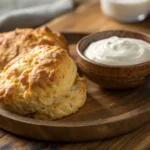
Homemade Biscuit Nutrition – The Complete Guide to Healthier Comfort Food
- Total Time: 30 minutes
- Yield: 8 biscuits 1x
- Diet: Vegetarian
Description
Classic homemade biscuits that are flaky, buttery, and perfect for breakfast or as a dinner side. Made with simple ingredients and no special tools required.
Ingredients
- 2 cups all-purpose flour
- 1 tbsp baking powder
- 1/2 tsp baking soda
- 1/2 tsp salt
- 6 tbsp unsalted butter, cold and cubed
- 3/4 cup whole milk or buttermilk
- Extra flour for dusting
- Butter for brushing (optional)
Instructions
- 1. Preheat oven to 425°F (220°C) and line a baking sheet with parchment paper.
- 2. In a large bowl, whisk together the flour, baking powder, baking soda, and salt.
- 3. Add the cold butter and cut it in using a pastry cutter or your fingers until the mixture resembles coarse crumbs.
- 4. Pour in the milk and mix just until a soft dough forms. Do not overmix.
- 5. Turn the dough out onto a lightly floured surface and gently pat it into a 1-inch thick rectangle.
- 6. Fold the dough over itself once or twice, then pat it out again and cut into rounds using a biscuit cutter.
- 7. Place biscuits onto the baking sheet, close together for soft sides or spaced apart for crisper edges.
- 8. Bake for 12–15 minutes, or until golden brown.
- 9. Brush tops with melted butter if desired and serve warm.
Notes
Keep your ingredients cold for flakier biscuits—chill the butter and even the flour if possible.
Do not overwork the dough; a light touch results in tender biscuits.
These freeze well before or after baking. Reheat in the oven for best texture.
Perfect with jam, honey, gravy, or eggs for breakfast.
- Prep Time: 15 minutes
- Cook Time: 15 minutes
- Category: Breakfast
- Method: Baking
- Cuisine: American
Nutrition
- Serving Size: 1 biscuit
- Calories: 210
- Sugar: 2g
- Sodium: 400mg
- Fat: 10g
- Saturated Fat: 6g
- Unsaturated Fat: 3g
- Trans Fat: 0g
- Carbohydrates: 26g
- Fiber: 1g
- Protein: 4g
- Cholesterol: 25mg
Keywords: homemade biscuits, classic biscuits, flaky biscuits, buttery biscuits
Macronutrients in a Standard Homemade Biscuit
Here’s a general macronutrient breakdown for one medium (2.5-inch) homemade biscuit (about 55g):
| Nutrient | Amount (per biscuit) |
|---|---|
| Calories | 180–220 kcal |
| Carbohydrates | 22–25 g |
| Fat | 9–12 g |
| Saturated Fat | 5–7 g |
| Protein | 3–4 g |
| Fiber | <1 g |
| Sodium | 300–500 mg |
Keep in mind, variations in butter quantity or biscuit size can significantly impact homemade biscuit nutrition stats. Recipes that use heavy cream or extra butter can push fat content up to 15g per biscuit.
Discover great ideas like our Lemon Sandwich Biscuits if you enjoy sweet-tangy flavors and want something similar but refreshing.
Calorie Count of Homemade Biscuits
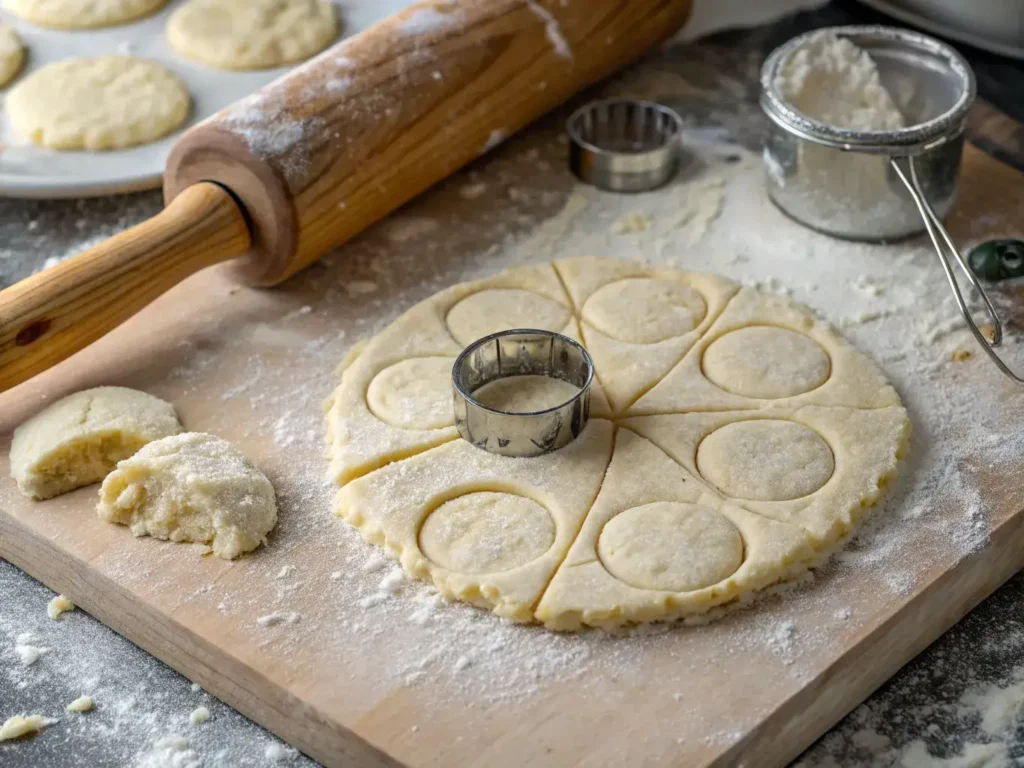
How Many Calories in a Homemade Plain Biscuit?
The calorie count in homemade biscuits depends on portion size, ingredients, and cooking method. On average, one medium-sized plain biscuit contains 180 to 220 calories. The higher end applies when whole milk, extra butter, or heavy cream is used.
Average Calorie Range by Size:
| Biscuit Size | Calories (Plain) |
|---|---|
| Small (35g) | 120–150 kcal |
| Medium (55g) | 180–220 kcal |
| Large (75g) | 240–280 kcal |
Calories are mainly derived from refined carbohydrates and saturated fats, two primary components of traditional recipes.
Don’t miss our Healthy Desserts with Dates if you’re interested in calorie-smart alternatives.
Factors That Influence Calorie Content
Several elements influence the caloric value of homemade biscuits:
- Type of fat used: Butter, shortening, and lard have different calorie densities.
- Flour choice: Whole wheat adds fiber but slightly more calories.
- Dairy used: Buttermilk vs. heavy cream can cause a 20–50 calorie swing.
- Size: A thicker biscuit naturally has more calories.
- Add-ons: Toppings like honey, jam, or gravy increase total calories fast.
Choosing lighter ingredients or halving the portion size is a smart way to manage homemade biscuit nutrition without sacrificing flavor.
Macronutrient Breakdown – Carbs, Fats, and Protein
Carbohydrates in Homemade Biscuits
Carbs form the bulk of any biscuit, as most are made with all-purpose white flour. A single biscuit typically contains 22–25g of carbohydrates, primarily simple carbs with a high glycemic index.
| Source | Contribution to Carbs |
|---|---|
| Flour | 80–90% |
| Dairy | 5–10% |
| Sugar (if added) | 5–10% |
High-carb biscuits can cause quick blood sugar spikes, which may not be ideal for diabetics or people on low-carb diets.
Fat Content and Types of Fat Used
A major contributor to homemade biscuit nutrition is fat. A medium biscuit contains between 9 to 12 grams of fat, often 4–7g of which is saturated fat. This fat comes from:
- Butter
- Shortening
- Whole milk or cream
Comparison of Common Fat Sources:
| Ingredient | Fat per 1 tbsp | Type |
|---|---|---|
| Butter | 11g | Saturated |
| Coconut oil | 14g | Saturated (plant) |
| Olive oil | 14g | Monounsaturated |
| Greek yogurt | 0–2g | Low-fat replacement |
To reduce fat without losing texture, some bakers use applesauce or Greek yogurt to partially replace fat—an excellent way to boost nutrition.
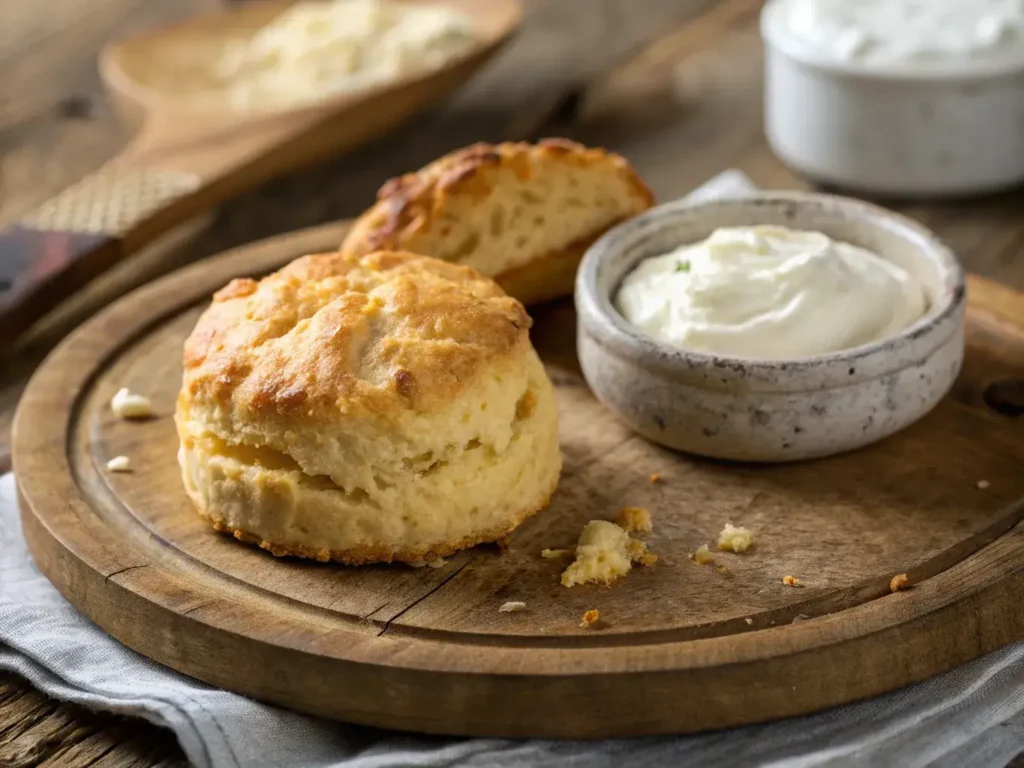
Vitamins and Minerals in Homemade Biscuits
Which Micronutrients Are Present?
While biscuits are not vitamin-rich, they do provide small amounts of key micronutrients:
- Calcium: From milk or buttermilk
- Iron: From enriched flour (in small amounts)
- Sodium: High levels from salt and baking powder
However, most vitamins are minimal unless the biscuit includes added nutrient-rich ingredients like cheese, eggs, or whole grain flour.
Micronutrient Snapshot:
| Nutrient | Amount (per biscuit) | % Daily Value |
|---|---|---|
| Calcium | 60–90 mg | 6–9% |
| Iron | 0.8–1.2 mg | 5–7% |
| Sodium | 300–500 mg | 13–21% |
Are Homemade Biscuits a Good Source of Fiber or Iron?
In standard recipes, the answer is no. Most homemade biscuits made with white flour contain less than 1g of dietary fiber. Switching to whole wheat flour can boost fiber content to 2–3g per biscuit, making them slightly more nutritious and more filling.
Are Homemade Biscuits Healthy?
Nutritional Pros and Cons
When evaluating homemade biscuit nutrition, you’ll find both upsides and drawbacks depending on ingredients and portions.
Pros
- Made from scratch with simple ingredients
- Can be adjusted for dietary needs
- Lower in preservatives compared to store-bought versions
- Can be enriched with fiber and protein
Cons
- Often high in saturated fat and sodium
- Low in fiber when made with white flour
- Calorie-dense and not very filling
- May spike blood sugar due to refined carbs
Don’t miss our Gluten Free Cheese Stick Recipe for another DIY snack option with more protein and fewer carbs.
When Can Biscuits Fit into a Balanced Diet?
Homemade biscuits can fit into a balanced diet when:
- Eaten in moderation
- Paired with protein-rich sides (e.g., eggs or lean meat)
- Made using healthier swaps like whole grains or reduced-fat ingredients
- Reserved for special occasions or controlled treats
Including biscuits occasionally doesn’t ruin your health goals, but eating several per day as a staple can tip the scale.
Biscuits vs. Bread – Which Is Healthier?
Nutrition Face-Off: Biscuits vs. White and Whole Wheat Bread
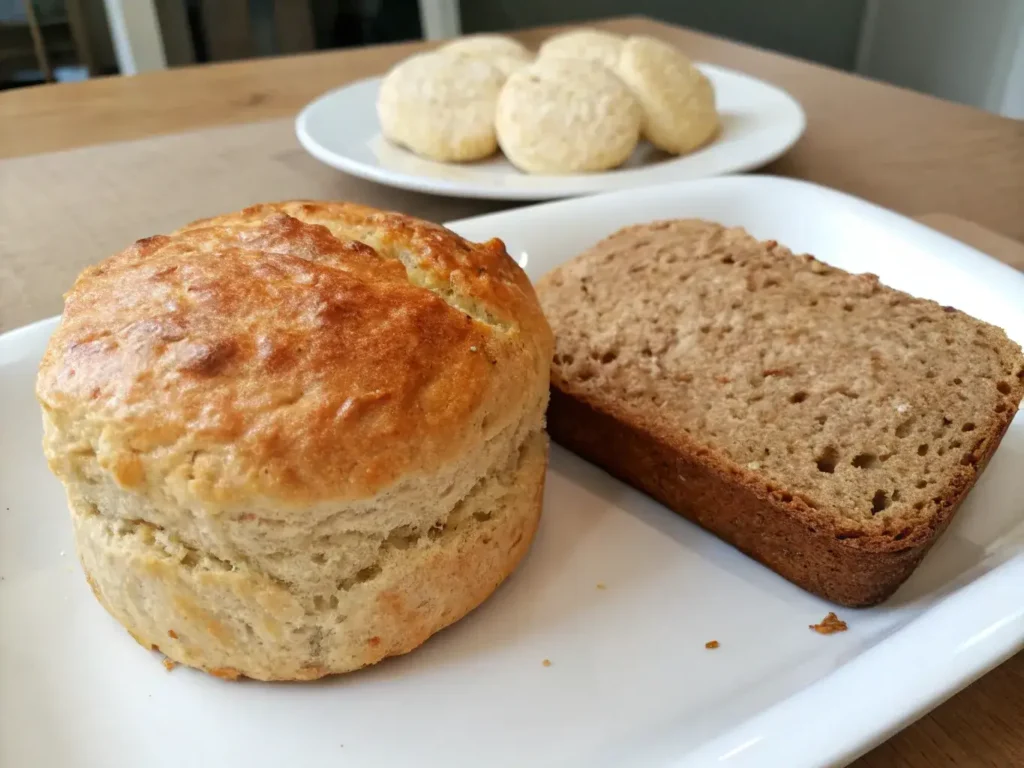
Let’s compare a standard homemade biscuit to a slice of bread:
| Item | Calories | Carbs | Fat | Fiber |
|---|---|---|---|---|
| Biscuit (55g) | 200 | 23g | 10g | <1g |
| White Bread Slice | 70–90 | 13g | 1g | 0.6g |
| Whole Wheat Bread | 80–100 | 12g | 1g | 2–3g |
Verdict: Bread (especially whole wheat) offers fewer calories, less fat, and more fiber than biscuits. For anyone monitoring heart health or blood sugar, bread is often the better option.
Which Option Is Better for Weight Loss or Low-Carb Diets?
- Weight loss: Whole wheat bread wins due to lower calories and higher satiety.
- Low-carb: Neither is ideal, but you can bake almond flour biscuits or use keto recipes as a workaround.
Biscuits don’t have to be off-limits. They just need to be carefully portioned and occasionally enjoyed.
Looking for lighter indulgences? Don’t miss our Moist Strawberry Banana Cake for a naturally sweet, gluten-free option.
Healthier Biscuit Alternatives
Swaps: Whole Wheat, Gluten-Free, Low-Fat Options
You can improve homemade biscuit nutrition significantly with ingredient tweaks:
- Use whole wheat flour: Boosts fiber and nutrients
- Try Greek yogurt instead of butter: Reduces fat and adds protein
- Skip added sugar: Let the biscuit flavor shine
- Add flaxseed or chia: Enhances fiber and Omega-3s
- Opt for plant-based milk: Lowers saturated fat
These alternatives retain flavor while making biscuits lighter on the gut and the waistline.
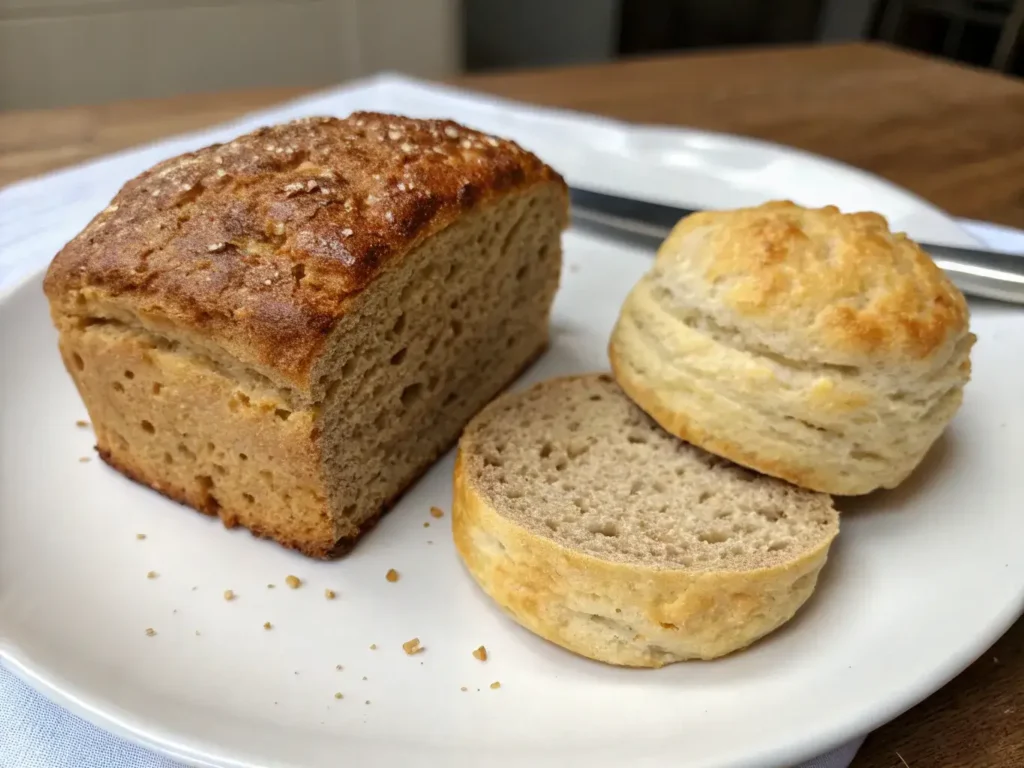
How to Modify Recipes for Health Benefits
| Traditional Ingredient | Healthier Swap |
|---|---|
| All-purpose flour | Whole wheat or oat flour |
| Butter | Avocado oil or Greek yogurt |
| Whole milk | Unsweetened almond milk |
| Salt | Low-sodium baking powder |
You’ll find that these swaps do not drastically affect taste or texture, but they deliver powerful nutrition boosts.
Discover great ideas like our Gluten Free Mozzarella Cheese Sticks that fit special diets with flavor intact.
Homemade Biscuit Recipes with Better Nutrition
Examples of Lighter, Healthier Biscuit Recipes
Here are three upgraded biscuit types that balance flavor and wellness:
- Whole Wheat Buttermilk Biscuits
- 180 calories
- 4g fiber
- 6g fat
- Greek Yogurt Almond Flour Biscuits
- 150 calories
- 9g protein
- Low carb
- Gluten-Free Oat Biscuits with Honey
- 165 calories
- Naturally sweetened
- High in fiber and low in saturated fat
Nutritional Comparison Table of Variations
| Biscuit Type | Calories | Fat | Carbs | Fiber | Protein |
|---|---|---|---|---|---|
| Traditional Butter Biscuit | 220 | 12g | 25g | <1g | 3g |
| Whole Wheat Biscuit | 180 | 6g | 23g | 4g | 4g |
| Almond Flour + Yogurt Biscuit | 150 | 5g | 12g | 2g | 9g |
Making these simple recipe swaps can completely transform your homemade biscuit nutrition profile while still satisfying your cravings.
Practical Tips to Make Your Biscuits Healthier
Portion Control and Ingredient Tweaks
Small changes can make a big nutritional difference without sacrificing flavor. Here’s how to upgrade your homemade biscuit nutrition game:
- Smaller cuts: Use a 2-inch cutter instead of 3-inch to cut down on portion size and calories.
- Skip the second helping: Serve biscuits with protein-rich dishes like eggs or turkey bacon to stay full longer.
- Use parchment paper: Reduces the need to grease pans, cutting unnecessary fat.
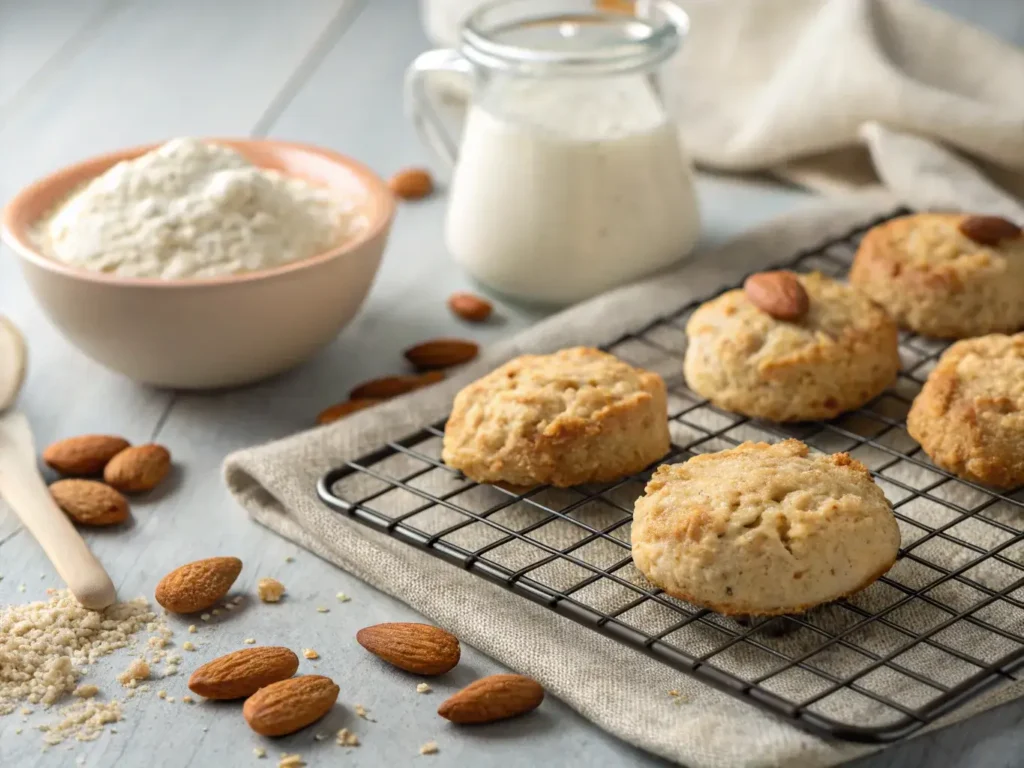
You don’t have to avoid biscuits—you just need to outsmart the recipe.
Baking Methods That Reduce Calories
Simple baking techniques can help:
- Avoid brushing with butter before baking – save ~40 extra calories per biscuit
- Use convection oven settings – cooks evenly with less need for fat
- Chill dough before baking – reduces spread, creating fluffier, denser biscuits that satisfy with less
Use a food scale to portion dough for consistent caloric intake, a smart trick for anyone tracking their macros or calories.
Looking for healthier dessert options? Try our Carrot Protein Cake, full of flavor and fiber!
Frequently Asked Questions (FAQs)
What is the nutritional value of homemade biscuits?
A standard homemade biscuit contains 180–220 calories, 9–12g of fat, 23–25g of carbohydrates, and around 3–4g of protein. The nutrition profile varies with ingredients and portion size.
Are homemade biscuits healthy?
They can be! Traditional versions are rich in calories and saturated fats, but by using whole grains, low-fat dairy, and reducing portion sizes, you can enjoy biscuits as part of a healthy diet.
Are biscuits better for you than bread?
Typically, no. Whole wheat bread tends to be lower in calories and fat, and higher in fiber. But a modified biscuit recipe using healthier ingredients can be a competitive alternative.
How many calories in a homemade plain biscuit?
A plain biscuit averages 180–220 calories, depending on the size and ingredients. Skipping butter on top or using low-fat milk can reduce calories.
Conclusion
Homemade biscuits don’t have to be a guilty pleasure. When baked with mindfulness and a few smart swaps, they can be a satisfying addition to your meal plan. With options like whole grain flours, Greek yogurt, and plant-based ingredients, you can enjoy the same comforting bite, without sacrificing your health. Whether you’re tracking macros, following a balanced diet, or just want to eat smarter, the path to better homemade biscuit nutrition starts in your kitchen.

